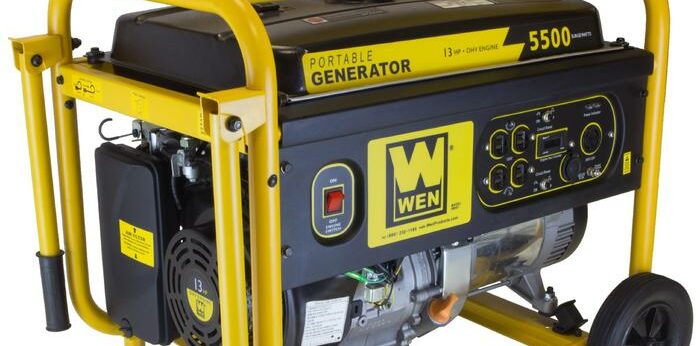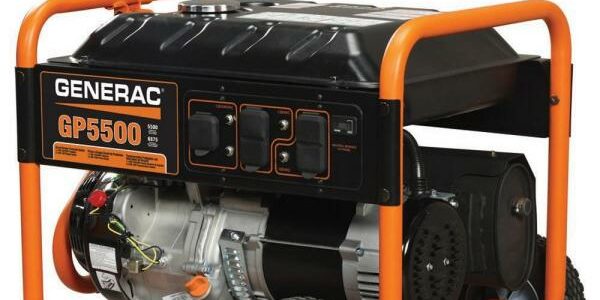What will a 5500-watt generator will run? Are you interested in purchasing a generator rated for 5500 watts but not sure what it will be capable of running? Well, if you answered yes to that question, you are at the right place. We’re here to give you the correct information to help you in selecting your 5500-watt generator.
Power outages happen at the most inconvenient of times. When they do, it’s essential to have a power generator you trust. Generators in the 5,000 to the 7,000-watt range are generally strong enough to power the most common household items in houses that are 1,200-3,000 square feet.
A 5,500-watt generator is an excellent way to go when you’re looking to replace an electrical source during a power outage. It’s not the most powerful generator on the market, but it will cover your needs for essential household appliances.

What Will a 5500-Watt Generator Run?
It is essential to find out how many amperes can a 5500-watt generator provide. This will help you determine what you can run on it. A 5500-watt generator can provide up to 45 amps if the voltage is 120 or up to 23 amps if the voltage is 240.
In simple terms, a 5500-watt generator can power all your electricity needs. It can power electrical appliances listed in the table below.
| Sr. No. | Electrical appliance | Watt Requirement | Sr. No. | Electrical appliance | Watt Requirement |
| 1 | Small Window AC | 1200 | 14 | Sump Pump | 1050 |
| 2 | Fridge + Freezer | 700 | 15 | Small heater | 500 |
| 3 | Small Pump | 1000 | 16 | Laptop | 50 |
| 4 | Washing Machine | 1150 | 17 | DVD Player | 100 |
| 5 | Coffee Maker | 1000 | 18 | Small Electric appliance | 400 |
| 6 | Microwave Oven | 1000 | 19 | Power tools | 800 |
| 7 | Dishwasher | 1500 | 20 | Medium Radiant Heater | 1800 |
| 8 | Pressure Cooker | 700 | 21 | Window AC | 1200 |
| 9 | Espresso Machine | 1300 | 22 | Electric Water Heater | 4000 |
| 10 | Toaster | 850 | 23 | Bench Grinder | 1400 |
| 11 | Ceiling Fan | 60 | 24 | Radial Arm Saw | 2000 |
| 12 | Vacuum Cleaner | 200 | 25 | Hammer Drill | 1000 |
| 13 | TV | 85 |
Power Requirements of Some of Home Appliances:
To know how much power, you need to run your home appliances, figure out the power needs of each one. The list below will help you with some of the most common products and their power consumption needs.
| Sr. No. | Electrical appliance | Watt Requirement | Sr. No. | Electrical appliance | Watt Requirement |
| 1 | Light Bulb | 100 | 14 | Handheld Leaf Blower | 2500 |
| 2 | 55 Inch LED TV | 116 | 15 | Electric Blanket | 200 |
| 3 | 82 Inch LED TV | 285 | 16 | Electric Boiler | 4000 |
| 4 | Air Cooler | 80 | 17 | Electric Kettle | 3000 |
| 5 | Air Fryer | 1500 | 18 | Electric Shaver | 20 |
| 6 | Aquarium Pump | 50 | 19 | Electric Stove | 2000 |
| 7 | Ceiling Fan | 70 | 20 | Thermal Radiator | 500 |
| 8 | Cloth Dryer | 4000 | 21 | Air Conditioner | 2600 |
| 9 | Computer Monitor | 30 | 22 | Food Dehydrator | 800 |
| 10 | Corded Drill | 850 | 23 | Game Console | 200 |
| 11 | Curling Iron | 35 | 24 | Heat Hair Rollers | 400 |
| 12 | Deep Freezer | 19 | 25 | Home Phone | 5 |
| 13 | Desktop Computer | 450 |
If you are purchasing a generator, you should also know what type of outlets it has. Some appliances require different outlets than others. So, if you have high-wattage appliances such as an AC unit, you may need a generator with a different outlet type than your low-wattage appliances like a LED light.
Figure Out Specific Number of Watts an Appliance Requires
To determine What will a 5500-watt generator run? You need to know the wattage requirement for your appliances. Every appliance will be written somewhere in watts on the appliance’s tag or sticker, which is usually located near the motor or on the bottom.
Imagine that you have a bunch of appliances running at the same time. Let’s say you have a refrigerator, furnace fan, and sump pump. If you use 700 watts for the fridge and 1050 watts for the furnace fan, do you know how many watts these appliances use in total?
If so, use the below equation to find out.
Power (in Watts) = AMPS x VOLTS
Take the number of amperes and multiply it by the number of volts to get your answer in Watts for each appliance. Add up all the watts to find out how many watts these appliances use in total.
Determine the Number of Watts an Appliance Needs to Start-up
All appliances have two types of wattage: “startup” and “running.” Startup wattage is the power needed when the particular appliance will start. Running wattage is the wattage when a device is in operation.
Electric motors require about twice as much startup wattage, but they operate at the same wattage as stated on the product after they start. To make things simpler, let’s say you have a sump pump that’s using 1,050 watts.
When it starts up, it uses around 2,000 watts. A furnace motor with 1/3 of horsepower needs about 1400 watts to start up. For many electric appliances, the amount of wattage needed to start varies. Heat-producing appliances, such as televisions, coffee pots, and electric water heaters, don’t need extra watts to start up.
Wattage Variations in 5500-Watt Generator
When it comes to a 5500-watt generator, this refers to a machine that can produce 5500 running watts. The starting wattage of a generator can vary depending on the model and brand.
Though we cannot give you a precise number, our experience suggests that the startup wattage lies in the range of 6000-7000 surge watts. A house is likely going to need a lot more power than this generator can provide. You can certainly expect to run some things off of it, but not simultaneously.

Final Thoughts
So, now you finally know what a 5500-generator is capable of running, what are you waiting for? A 5500 watts generator can power most of your appliances at home, but you need to make sure it’s not competing with your other devices.
To start it up, unplug any other electronic devices. The device’s draw calculates the wattage during startup rather than how it functions while running, so make sure you don’t overload your generator.
It is essential not to exceed the wattage of 5500 watts when running your water heater. To run one tool with 4500 watts, for instance, please unplug all other appliances. Doing this will increase the efficiency and effectiveness of the generator and extend the working life.